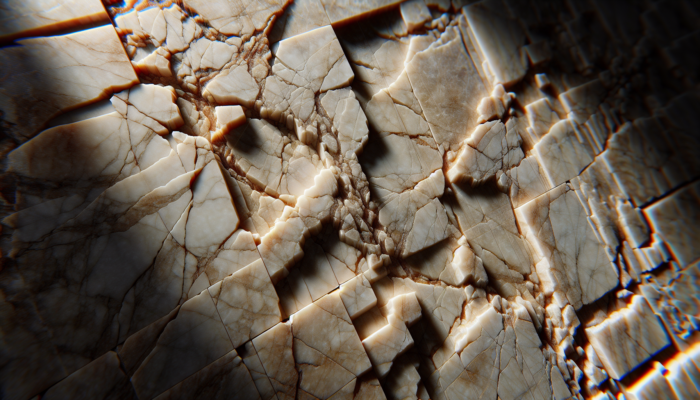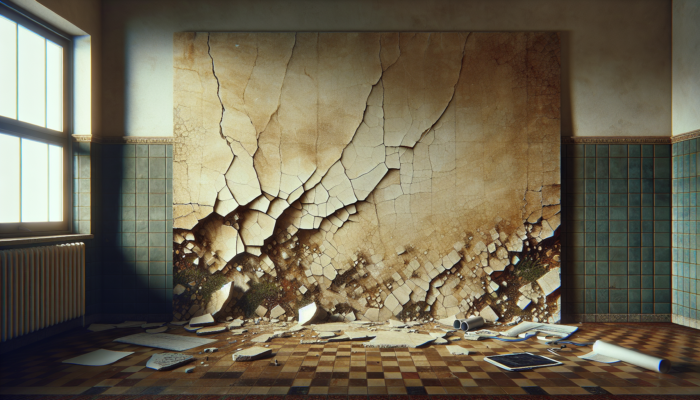Your Comprehensive Guide to Assessing and Restoring Damaged Travertine Tiles
Effective Strategies for Identifying Cracks and Surface Imperfections

An exhaustive and thorough evaluation of travertine tiles is paramount when assessing the potential for repairing cracked tiles within your residence. Initiate your inspection by meticulously examining the tiles for visible cracks, chips, or surface flaws. Employing a robust light source can significantly assist in uncovering imperfections that may otherwise escape your notice. Concentrate particularly on chips, fissures, and any anomalies evident on the tile's surface. Furthermore, understanding the precise locations of these cracks is critical. While some may be superficial and readily repairable, others could indicate deeper, underlying issues that require a more cautious and well-informed approach to manage them effectively.
Across numerous households in Britain, particularly in regions experiencing significant temperature fluctuations, travertine tiles are notably susceptible to cracking due to the natural expansion and contraction of the material. It is wise to pay extra attention to tiles positioned near exterior walls, where moisture intrusion can exacerbate deterioration over time. Grasping the extent of the damage is crucial, as it influences your repair strategies and determines whether a DIY approach is feasible for your particular circumstances.
Exploring the Various Types of Cracks Found in Travertine Tiles
Cracks in travertine tiles can manifest in different forms, primarily classified as hairline, surface, and deep cracks. Hairline cracks are generally minor and often do not compromise the structural integrity of the tile. These cracks are typically amenable to treatment with specialised fillers specifically designed for travertine, rendering them ideal candidates for DIY repair projects.
Surface cracks may extend slightly deeper but can still be manageable at home with the right tools and materials. It’s essential to evaluate whether these surface cracks affect the overall aesthetics or functionality of the tile. Conversely, deep cracks may signify underlying complications, such as improper installation methods or severe structural challenges, which are best addressed by professionals. Recognising the specific type of crack you face will significantly aid in crafting a tailored and effective repair strategy suited to your unique situation.
Prioritising Safety Measures Before Initiating Travertine Tile Repair Tasks
Emphasising safety is paramount before embarking on any repair endeavour. Equip yourself with appropriate protective gear, including safety goggles, gloves, and a dust mask, to shield yourself from sharp debris or harmful dust generated throughout the repair process. Given that travertine tiles can be quite substantial, broken pieces may pose a risk of injury; therefore, exercising extreme caution when lifting or handling them is prudent.
Moreover, it is advisable to work in a well-ventilated environment to mitigate inhalation of fumes from adhesives or fillers. When utilising power tools, ensure they are in excellent working order and comply with all manufacturer safety guidelines. This not only safeguards your well-being during the repair process but also fosters a safer environment for anyone else present in your home, thereby facilitating a smooth and efficient repair experience.
Assessing the Structural Integrity of Your Travertine Tiles

Evaluating the structural integrity of your travertine tiles is an integral aspect of your repair procedure. If you notice extensive cracking or if the tiles feel unstable underfoot, this may indicate a more serious underlying problem. Look for loose tiles or sections that might have shifted, as these signs can point to foundational issues necessitating professional evaluation for effective resolution.
Additionally, scrutinising the underlying substrate is crucial; if the underlayment is compromised, it could lead to further damage in the future. If you suspect that the cracks merely represent a symptom of a more significant issue, do not hesitate to consult a professional before attempting any repairs. Understanding the structural integrity of your tiles directly influences your ability to confidently address the question: Can cracked travertine tiles be repaired at home?
Essential Tools and Materials Needed for Travertine Tile Repair Projects
Gathering the Proper Tools for Successful Travertine Tile Repairs
Embarking on a successful travertine tile repair project necessitates having the right tools to ensure optimal outcomes. Key tools include a grout saw for efficiently removing old grout from around the damaged area, a trowel for spreading filler, and a utility knife for executing precise cutting tasks. Additionally, possessing safety goggles is vital to protect your eyes from dust and debris throughout the repair process.
A vacuum or a soft brush is also indispensable for cleaning the tiles both before and after repairs, ensuring that the surface is smooth and primed for the application of repair materials. Should you be addressing deeper cracks, consider using chisels or a hammer to judiciously chip away damaged sections of tile. Having these essential tools readily accessible will streamline your repair process, enhancing efficiency and allowing you to confidently respond to the question, “Can cracked travertine tiles be repaired at home?”
Selecting High-Quality Materials for Effective and Lasting Repairs

Choosing the appropriate repair materials is vital for achieving a durable and visually appealing finish for your travertine tiles. Travertine fillers, typically epoxy-based, are ideal for effectively filling cracks, especially those that are deeper or more significant. These fillers are specially formulated for natural stone and will bond effectively to the travertine surface, ensuring strong adhesion.
A simple resin filler is also highly effective for minor hairline cracks. Furthermore, if any tiles require replacement, you will need an appropriate adhesive. It’s essential to ensure that the materials selected are compatible with travertine and suitable for indoor use, particularly in moisture-prone areas such as kitchens or bathrooms. This careful selection of materials is crucial for achieving a successful repair that stands the test of time.
Where to Obtain Essential Supplies for Travertine Tile Repairs
Numerous suppliers across the UK offer the necessary tools and materials for travertine tile repairs. DIY stores like B&Q, Homebase, and Screwfix boast an extensive selection tailored to your requirements. Additionally, specialised stone supply companies frequently provide high-quality fillers and adhesives specifically designed for stone restoration needs. Online marketplaces, such as Amazon, can also serve as a convenient option, allowing you to compare products and peruse customer reviews before making a purchase.
Local tile suppliers may provide specific recommendations tailored to your project’s needs, so don’t hesitate to seek their expert advice on the best products for your requirements. Sourcing your materials wisely can significantly enhance the likelihood of a successful and satisfying repair process, ultimately ensuring your travertine tiles remain in excellent condition.
Thoroughly Preparing the Surface to Ensure Successful Repairs
Implementing a Detailed Cleaning Process for the Travertine Tiles
Before initiating repairs, it is essential to meticulously clean the tiles to guarantee proper adhesion of fillers and adhesives. Start by sweeping the area to eliminate surface dust and debris. Follow this by mopping with a damp cloth using a gentle cleaning solution specifically formulated for stone, as harsh chemicals can cause irreversible damage to travertine tiles.
This step is critical to ensure the tiles dry completely after cleaning. Any moisture remaining on the surface can interfere with the repair materials, potentially leading to unsatisfactory results. A clean and dry surface not only improves the effectiveness of the repair but also promotes a more seamless finish, reaffirming the question of whether cracked travertine tiles can be repaired at home.
Carefully Removing Old Grout to Facilitate Effective Repairs
To ensure a successful repair, it is vital to meticulously remove the old grout from around the damaged area. Using a grout saw or a utility knife, carefully scrape out the old grout without causing damage to the surrounding tiles. Take your time and work methodically, as rushing this process can lead to further damage or uneven edges that detract from the overall results.
After removing the old grout, vacuum the area to eliminate any residual debris. This preparation step is essential for ensuring that the new grout will adhere properly, providing a robust bond and significantly improving the appearance of the repaired area. Properly preparing the surface lays the foundation for a successful travertine tile repair project, ensuring lasting results.
Verifying That the Surface is Completely Dry Before Proceeding with Repairs
Once the tiles are clean and the old grout has been removed, it is crucial to ensure that the surface is entirely dry before proceeding with repairs. Any residual moisture can compromise the integrity of the repair materials, leading to bubbling or peeling. This drying process may take several hours or longer, depending on humidity levels and ventilation.
Consider utilising a fan to expedite the drying process, particularly in enclosed spaces. A thoroughly dried surface not only allows for better adhesion but also enhances the longevity of the repairs, making it a vital consideration in your DIY journey to restore your travertine tiles.
Conducting a Comprehensive Damage Assessment Before Repairs
Before proceeding with repairs, carry out a comprehensive inspection of the tiles. Look for any additional cracks, chips, or signs of wear that may not have been immediately noticeable. Furthermore, pay careful attention to the condition of grout lines, as they can indicate potential water damage or instability in the structure.
Identifying any further damage early allows you to address these issues efficiently and prevent them from worsening over time. If you discover extensive damage or underlying structural concerns, it may be wise to consult with a professional before continuing with repairs. This proactive approach ensures that your efforts to address the question, “Can cracked travertine tiles be repaired at home?” are not in vain, ultimately safeguarding your investment.
Effective Repair Techniques for Minor Cracks in Travertine Tiles
Filling Hairline Cracks with Precision and Expertise
Hairline cracks should be thoroughly assessed to determine whether they are likely to lead to further damage. If there is a risk of additional damage, these hairline cracks may need to be widened using diamond tooling, allowing for effective repair with a filler specifically designed for travertine.
For optimal results, adhere to the manufacturer's instructions regarding the filler product, which may suggest specific application techniques or drying times. After filling, use a damp cloth to gently wipe away any excess filler around the crack's edges, ensuring a smooth and professional finish. This attention to detail not only enhances the appearance of the repaired area but also fortifies the integrity of the tile.
Smoothing the Repaired Surface to Achieve a Flawless Finish
Once the filler has dried according to the manufacturer’s recommendations, it’s time to smooth the surface for a flawless finish. Utilise fine-grit sandpaper or a sanding block to gently sand the repaired area until it aligns perfectly with the surrounding tile surface. This step is crucial; an uneven finish can be visually distracting and detract from the overall aesthetic of your travertine tiles.
Exercise caution during this process, as excessive sanding can damage the adjacent tiles. After sanding, thoroughly clean the area to remove any dust particles generated during the process. This careful approach ensures that the repaired area seamlessly blends with the original surface, significantly enhancing the visual appeal and durability of your travertine tiles.
Recognising the Importance of Allowing Sufficient Drying Time
Understanding the drying time for different filler types is essential for successful repairs. Most travertine fillers have specific drying times outlined in their product instructions, typically ranging from a few hours to 24 hours. Adhering to these recommendations is crucial, allowing the filler ample time to cure before exposing it to foot traffic or moisture.
Patience during this phase is vital; rushing the process can lead to unsatisfactory results, with the risk of the filler cracking or peeling away. For optimal outcomes, ensure that the environment is well-ventilated, as this can also help to expedite drying times. A properly cured filler guarantees a durable and long-lasting repair, making it a key consideration in your DIY repair project.
Effectively Addressing Major Cracks in Travertine Tiles
Chipping Out Damaged Sections with Precision and Care
When faced with significant cracks in travertine tiles, the initial step typically involves carefully chipping out the damaged areas. Begin by evaluating the extent of the damage using a chisel or utility knife. Gently chip away the damaged section, being cautious to avoid harming the surrounding tiles. This method enables you to create a clean area for applying epoxy or filler effectively.
Once the damaged area is removed, thoroughly clean the site to ensure a good bond with the repair materials. Confirm that there are no loose pieces or debris remaining, as these can adversely affect the adhesion of the epoxy. After adequately preparing the area, you can confidently proceed with the subsequent steps of your repair process while keeping in mind the question of whether cracked travertine tiles can be repaired at home.
Applying Epoxy for Larger Cracks with Assurance
Epoxy is the preferred repair material for larger cracks or damaged areas. Mixing epoxy entails combining a resin with a hardener, making it essential to adhere closely to the manufacturer’s guidelines for optimal results. After mixing, use a putty knife to apply the epoxy to the damaged area, ensuring it fills the space completely and adheres to the edges of the surrounding tiles.
Working swiftly is crucial, as epoxy has a limited working time before it begins to cure. Once applied, smooth the epoxy’s surface to match the surrounding tile. Be diligent about cleaning any excess epoxy around the edges before it hardens, as this will create a significantly cleaner and more visually appealing final finish.
Finishing Touches for a Professional Appearance
Once the epoxy has cured according to the manufacturer’s instructions, it’s time to apply the finishing touches. Gently sand the cured epoxy to blend it seamlessly with the surface of the surrounding travertine tiles. This process may require fine-grit sandpaper to achieve a smooth and uniform finish that enhances the overall look.
Additionally, consider applying a suitable sealer over the repaired area to protect against moisture and stains. Sealing is an essential final step for travertine tiles, particularly in high-traffic areas or locations exposed to water, such as kitchens and bathrooms. Completing these finishing touches not only enhances the durability of the repair but also ensures your tiles maintain their aesthetic appeal over time, making them look as good as new.
Allowing Epoxy to Cure for Long-lasting Repairs
Properly curing epoxy is critical for ensuring a durable repair. Epoxy can take from a few hours to several days to fully cure, depending on environmental conditions and the specific product used. It is vital to closely follow the manufacturer’s guidelines regarding curing times to ensure optimal results.
During this curing period, avoid exposing the repaired area to water or heavy foot traffic, as this can compromise the integrity of the repair. A successful curing process will result in a robust bond that restores your travertine tiles’ functionality and appearance, making this step a crucial part of the repair journey.
Re-grouting and Sealing Travertine Tiles to Enhance Longevity
Choosing the Ideal Grout for Travertine Tiles
Re-grouting is a pivotal step following any repair, especially for areas where the grout has been disrupted or removed. Selecting the perfect type of grout for travertine tiles is vital for achieving a successful outcome. Latex or epoxy-based grout is often recommended due to its durability and moisture resistance; these properties make it perfect for high-traffic areas and locations exposed to water.
Consider the grout’s colour as well; finding a shade that closely matches the existing grout will help maintain a uniform appearance across your tiles. Consult with local suppliers or DIY stores for recommendations tailored to your specific needs, ensuring the grout selected is suitable for use with travertine tiles.
Applying New Grout with Care and Precision
Once you’ve selected the appropriate grout, it’s time to apply it effectively. Using a grout float, gently press the grout into the joints between tiles, ensuring no air pockets are present. Work methodically, filling in any gaps and smoothing the surface for a clean and professional finish that enhances the overall look of your tiled area. After application, utilise a damp sponge to wipe away excess grout from the tile surfaces, taking care to avoid disturbing the freshly applied grout in the joints.
Allow the grout to cure according to the manufacturer’s recommendations, typically 24 to 48 hours. During this curing period, avoid exposing the area to water or heavy foot traffic, as this can disrupt the curing process and compromise the effectiveness of the grout. Properly applied grout not only enhances the appearance of your tiles but also plays a crucial role in sealing them against moisture damage, ensuring their longevity.
Sealing Your Travertine Tiles for Enhanced Protection
Sealing your travertine tiles post-repair is of utmost importance for preventing future damage. A high-quality sealer acts as a protective barrier against moisture, stains, and dirt, thereby prolonging the lifespan of your tiles. It is advisable to select a penetrating sealer specifically formulated for natural stone, as these provide optimal protection without altering the natural appearance of the travertine.
Before applying the sealer, ensure that the grout has fully cured and that the tiles are clean and dry. Apply the sealer using a soft cloth or a roller, strictly adhering to the manufacturer’s instructions. Once applied, allow the sealer to cure as directed, typically for at least 24 hours, before permitting foot traffic in the area. This final sealing step ensures your travertine tiles remain beautiful and durable for many years to come, safeguarding your investment.
Recognising When Professional Assistance is Necessary for Travertine Tile Repairs
Identifying Situations Where DIY Repairs May Not Be Adequate
While many repairs can be managed at home, certain scenarios clearly necessitate professional intervention. Major structural damage, extensive cracking, or complications related to the substrate beneath the tiles are clear indicators that a DIY approach may fall short. If you observe significant movement in tiles or if cracks reappear shortly after a repair, it is advisable to consult a professional.
Moreover, if you are unfamiliar with the required materials or techniques, seeking expert assistance can save both time and money in the long run. Recognising when to engage professionals is essential to ensuring the longevity and durability of your <a href="https://tilecleaningsurrey.co.uk/home-garden/cleaning-travertine-surfaces-a-complete-uk-guide/">travertine surfaces</a>, ultimately protecting your investment.
Finding a Qualified Specialist for Travertine Repairs
When seeking professional assistance, it is crucial to locate a qualified travertine repair specialist in Surrey. Fabritec Tile Cleaning is an excellent choice, delivering exceptional service and results that meet and exceed expectations.
Understanding Cost Considerations Related to Professional Repairs
It is vital for homeowners to gain insight into the costs associated with professional travertine repairs. Prices can vary significantly based on the extent of the damage, the materials required, and your geographical location. Typically, minor repairs may range from £50 to £150, whereas extensive work can escalate into hundreds or even thousands of pounds.
Requesting quotes from multiple professionals will provide you with a clearer understanding of expected costs. Be sure to inquire about a detailed breakdown, including labour and materials, to avoid unexpected expenses. Being informed will empower you to make the best decisions regarding your travertine repair needs, ensuring a successful outcome.
Evaluating the Credentials of Professional Repair Services
Before hiring a travertine repair specialist, it is important to assess their credentials. Seek out professionals who are members of recognised industry associations, as this often signifies a commitment to quality and ethical standards. Review customer testimonials and feedback, as these provide valuable insight into previous work and overall customer satisfaction.
Requesting a portfolio of completed projects can also help you gauge their level of experience. A trustworthy professional will willingly share their qualifications and examples of their work, ensuring you feel confident in your hiring decision and the quality of the repair services offered.
Preparing for a Professional Visit to Your Home
If you’ve opted to enlist the help of a professional, preparing for their visit is essential for a smooth process. Clear the area surrounding the damaged tiles to facilitate easy access, and be ready to discuss the issues you’ve encountered, including any previous repair attempts.
Gather any relevant documentation, such as warranty information or previous inspections, to provide the specialist with a comprehensive understanding of the situation. This preparation not only aids the professional in diagnosing the problem but also ensures a more efficient repair process, allowing your travertine tiles to be restored beautifully and efficiently.
Common Inquiries About Travertine Repairs
What are the main causes of cracks in travertine tiles?
Cracks in travertine tiles can arise due to several factors, including thermal expansion, moisture penetration, or improper installation techniques. External pressure or impact can also contribute to cracking over time, potentially leading to significant damage if not addressed promptly.
Can I use any filler to repair travertine tiles?
To ensure proper adhesion and longevity, fillers specifically designed for travertine repairs must be utilised. Epoxy or resin-based fillers are typically recommended for achieving the best results, providing a reliable and durable solution for your repair needs.
What is the expected drying time for travertine repair materials?
Drying times can vary depending on the product employed. Most fillers and epoxies may take several hours to 24 hours to dry completely, while grout can require up to 48 hours for full curing. It is essential to follow the manufacturer’s guidelines for optimal results.
Should I seal my travertine tiles after completing repairs?
Yes, sealing your travertine tiles post-repair is highly advisable. A quality sealer protects against moisture, stains, and dirt, thereby prolonging the tiles’ lifespan and maintaining their overall appearance, ensuring they remain beautiful for years to come.
What tools are necessary for repairing travertine tiles?
Essential tools include a grout saw, trowel, putty knife, safety goggles, and a vacuum or soft brush for cleaning. For deeper repairs, chisels or hammers may also be required to ensure a thorough job, ensuring your repairs are effective and long-lasting.
How can I determine if I need professional assistance?
If you observe extensive cracking or instability in the tiles or if previous repairs have failed, it’s advisable to consult a professional. They can assess underlying structural issues that may not be apparent, providing peace of mind and ensuring the integrity of your tiles.
Is it possible to repair travertine tiles without prior experience?
While DIY enthusiasts can undertake many minor repairs, lacking experience can lead to unsatisfactory results. If unsure, consider seeking help from professionals to ensure the quality of work exceeds expectations and that your tiles are restored effectively.
What is the average cost of professional travertine repairs in the UK?
Costs for professional travertine repairs can vary widely based on the severity of the damage and the geographical location. Minor repairs might range from £50 to £150, while extensive work can exceed several hundred pounds, so budgeting accordingly is essential for homeowners.
How can I maintain my travertine tiles after completing repairs?
Regular cleaning with pH-neutral cleaners, avoiding harsh chemicals, and promptly addressing spills will help maintain your travertine tiles. Sealing every few years is also recommended for ongoing protection, ensuring your tiles remain in excellent condition for years to come.
Are there specific cleaning products formulated for travertine tiles?
Yes, it’s advisable to use cleaning solutions specifically designed for natural stone. These products are effective in cleaning without causing damage, preserving the integrity of your travertine tiles and ensuring they look their best.
The post Can Cracked Travertine Tiles Be Repaired at Home?: DIY Solutions appeared first on https://tilecleaningsurrey.co.uk
The Article Repairing Cracked Travertine Tiles: DIY Solutions at Home appeared first on https://fabritec.org
The Article DIY Solutions for Repairing Cracked Travertine Tiles Was Found On https://limitsofstrategy.com
The Article Repairing Cracked Travertine Tiles: DIY Solutions You Can Use found first on https://electroquench.com

